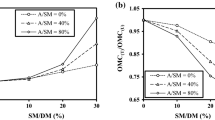Abstract
It is demonstrated that the strength properties of ceramic products molded from poorly sintering polymineral low-melting argillaceous materials and calcareous clays improve due to an increasing content of the total montmorillonite component in the batch; due to organogenic calcite in calcareous clays, which in firing facilitates the formation of a local reducing medium that affects the transformation of Fe3+ to Fe2+ and facilitates earlier sintering of clay; and due to a gypsum impurity contained in calcareous clays, which is an intense flux.
Similar content being viewed by others
References
G. L. Moisov, “The development of efficient chromophore additives for producing tinted ceramic brick at Krasnodar Region factories,” Stroit. Mater., No. 10, 16–18 (2001
A. V. Kornilov and E. N. Permyakov, “Classification of clay materials based on their mineralogical-technological varieties with prediction of finished product quality,” in: Proc. Intern. Scient. Conf. “Clay and Argillaceous Minerals” [in Russian], Voronezh (2004), pp. 71–
N. D. Yatsenko, N. A. Vil’bitskaya, S. P. Golovanova, et al., “Intensification of sintering of calcium-bearing ceramic mixtures,” Stroit. Mater., No. 9, 32–34 (2000
S. P. Golovanova, A. P. Zubekhin, and O. V. Likhota, “Bleaching and intensification of sintering of ceramics in using iron-bearing clays,” Stroit. Mater., No. 12, 9–11 (2004
A. I. Avgustinik, Ceramics [in Russian], Stroiizdat, Leningrad (1975).
N. S. Kashkaev and E. Sh. Sheinman, Production of Clay Brick [in Russian], Vysshaya Shkola, Moscow (1978).
R. V. Mkrtchyan, A. A. Shmakov, and R. A. Musaev, “Clay schist of Dzherdanskoe deposit as a high-quality ceramic material,” Stroit. Mater., No. 5, 29–31 (2002
A. K. Abdurakhmanov, A. M. Éminov, and G. N. Maslennikova, “Stages of ceramic structure formation in the presence of additives,” Stroit. Mater., No. 10, 21–23 (2000
Author information
Authors and Affiliations
Additional information
__________
Translated from Steklo i Keramika, No. 12, pp. 30–32, December, 2005.
Rights and permissions
About this article
Cite this article
Kornilov, A.V. Reasons for the different effects of calcareous clays on strength properties of ceramics. Glass Ceram 62, 391–393 (2005). https://doi.org/10.1007/s10717-006-0017-9
Issue Date:
DOI: https://doi.org/10.1007/s10717-006-0017-9




